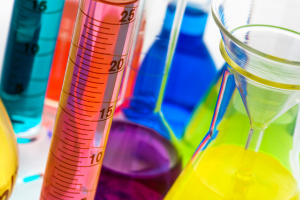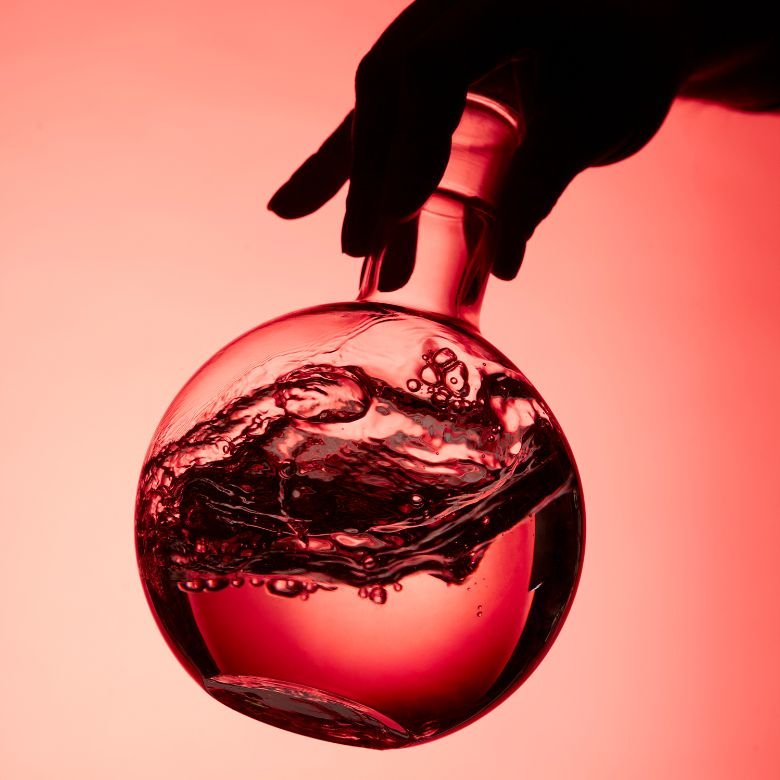Mixtures are two or more substances mixed together mechanically. They can occur in all three states of matter and they are easily divided into homogeneous and heterogeneous. So let’s get to know them better!

Division of mixtures
- If, to the naked eye, one cannot see the division of components in a mixture, the mixture is homogeneous. Examples of such mixtures are mineral water, perfumes and scented liquids or air.
- When the components of a mixture are visually distinguishable, thy are heterogeneous mixtures. Such mixtures, even after prolonged shaking or stirring, clearly have different layers.
Examples of heterogeneous mixtures
The first may be water with oil, in which case it is a mixture of two liquids that do not mix even during shaking, and oil droplets can easily be seen floating on the surface of the water. Another type of heterogeneous mixture is powdered chalk in water. It is a solid introduced into a liquid that does not dissolve in it. Mixing results in a slurry which, after some time, stratifies and the chalk particles sink to the bottom.
Solution
It is a particular type of mixture that consists of at least two components, one of which is called a solvent and the others are called substances dissolved in it. When two liquids or two gases are mixed, the solvent, otherwise known as the dispersive phase, is usually the substance that there is more of in solution. The substance in a lesser quantity is the one dissolved in it. Dissolved substances are also called the dispersed phase and there may be more than one of them in a solution. In such cases, we speak of multi-component solutions.
Commonly used solutions
On a day-to-day basis, it is most common to find solutions of various substances in water, possibly in organic solvents. In households, for example, solutions are used for various purposes, including:
- vinegar, a 10% solution of acetic acid,
- we use hydrogen peroxide for disinfecting wounds, i.e. a 3% solution of hydrogen peroxide,
- another solution – milk – is often added to coffee or breakfast cereal.
Examples of solutions in other states of matter include air, which is a mixture of mainly nitrogen, oxygen, water vapour and carbon dioxide, and bronze, a solid state solution made up of copper and tin. The amount of substance dissolved in the solvent determines which type it falls into – whether it is concentrated or dilute.
Types of solutions
There are several divisions of solutions depending on the parameters considered. The most important of these is the division into:
- A saturated solution is one that has been obtained by dissolving the maximum possible amount of a substance in a solvent. This means that it is not possible to dissolve any more of the dispersed phase under the given pressure and temperature conditions.
- An unsaturated solution is one in 100g of which, at a given temperature and pressure, it is still possible to dissolve larger amounts of the solute. The amount of substance present affects its concentration.
Among solutions, we also distinguish between:
- A dilute solution is a solution in which the amount of solvent is significantly greater than the amount of solute. These are usually solutions with a few per cent concentration.
- A concentrated solution is one in which the amount of substance of the dispersed phase relative to the dispersing phase is dozens per cent.
- A supersaturated solution is a specific system in which there is an additional amount of substance that cannot be dissolved under the given pressure and temperature conditions. This type of solution can easily be obtained by carefully cooling saturated solution. Such solutions are characterised by high instability and the system can be disturbed even by shaking more vigorously or throwing in an additional crystal of the substance, resulting in the complete crystallisation of the excess substance and the transition of the solution to the saturated state.
Several methods can be used to increase the saturation of a solution – increase the amount of solute, evaporate some solvent and, in the case of solids, saturation is also increased by lowering the temperature.
In the opposite situation, to reduce the saturation of the solution, the easiest way is to add more solvent to the system or, in the case of solids, to increase the temperature of the solution. Temperature manoeuvres are effective for liquid-solid systems, as they directly affect the solubility of the substance in the dispersing phase.

Solubility
The basic condition for the formation of a solution, i.e. an optically homogeneous mixture, is the occurrence of a process called dissolution. It involves the passage of molecules of a substance into solution. The reverse of this process is the formation of a solid crystalline phase, i.e. crystallisation of the substance.
Each substance has its own specific dissolution rate and efficiency. We can say that one substance is very soluble in water, for example, and another is very poorly soluble in water.
Solubility, on the other hand, is the number of grams of a substance that must be dissolved to obtain a saturated solution using 100 grams of solvent, under given conditions of pressure and temperature. The dissolution rate of a substance depends not only on the type of solvent, but also on:
- temperature, as the higher the temperature, the greater the energy of the particles, which in turn causes them to collide more and more frequently;
- mechanical mixing, which facilitates the mixing of particles;
- fineness of the solute, because the greater the fineness, the easier it is for the solvent particles to penetrate between the solute.
Familiarity with the concepts of solubility or the saturation level of solutions makes it possible to solve simple calculations that facilitate the daily work of every chemist. The solubility of many substances can be read from the solubility curves found in books, which show the temperature dependence of the number of grams of a substance.
Examples of chemical tasks in which the concept of solubility must be used
Task 1.
The solubility of substance X in water at a given temperature is
45 g. Calculate how many grams of solvent are contained in 600 g of saturated solution.
We know that the solubility is 45 g, which means that 45 g of a substance dissolves in 100 g of water, resulting in a saturated solution. The mass of the solution is the mass of the substance and the mass of the solvent present, so:
solution = 45 g + 100 g = 145 g
With this knowledge, we can arrange the ratio:
145 g solution – 100 g water
600 g solution – m g water
![]()
Task 2.
Calculate how many grams of ammonium chloride must be dissolved additionally in 100 g of water if you heat the solution from 50 oC to 80 oC so that the solution still remains saturated.
The following can be read off the ammonium chloride water solubility curve:
- The solubility at 50 oC is approximately 48 g.
- The solubility at 80 oC is approximately 64 g.
As the concept of solubility refers to the amount of a substance dissolved in 100 g of water, it is easy to calculate that additional dissolution is required to maintain a saturated solution:
64 g – 48 g = 16 g NH4Cl
Task 3.
What solution will be formed if a solution consisting of 100 g of water and 50 g of ammonium chloride is prepared at 60 oC?
Using the solubility curve, we know that at 60oC the solubility of ammonium chloride is: R = 55 g. This means that when 50 g of ammonium chloride is added to 100 g of water at this temperature, an additional 5 g could dissolve. The solution thus prepared is therefore unsaturated.